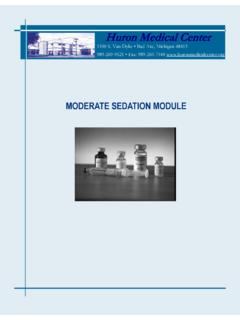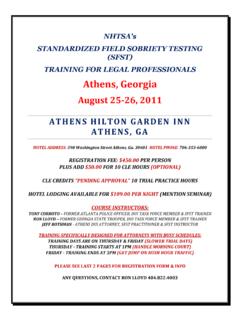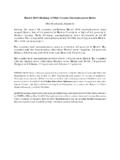Transcription of IV ADMIXING OUTSIDE OF PHARMACY Athens …
1 IV ADMIXING OUTSIDE OF PHARMACY Athens -Limestone Hospital 2013-14 TRAINING MODULE 1 CIHQ - All Rights Reserved 2013 Objectives By the end of this training module, the participant will be able to: Discuss the importance of competency related to ADMIXING OUTSIDE of PHARMACY Identify basic steps in IV ADMIXING OUTSIDE of PHARMACY Understand the importance of using aseptic techniques for ADMIXING CIHQ - All Rights Reserved 2013 2 Documented Competency CIHQ - All Rights Reserved 2013 3 All nurses who prepare sterile admixtures must have documented competency to do so. Competency assessment includes training & assessment of the nurse s competency to perform this skill.
2 Staff Competency IV ADMIXING CIHQ - All Rights Reserved 2013 4 When an onsite, licensed PHARMACY is available, sterile medications, IV admixtures, and other drugs are compounded or admixed only in the PHARMACY , EXCEPT in emergencies or when this practice is not feasible ( , when the duration of product stability is short). Admixture performed OUTSIDE of PHARMACY should be for short term / immediate use. IV ADMIXING Admixture system refers to sterile IV solutions that are prepared by using one or more medications or electrolytes and will be administered via the parenteral route (not through the digestive tract).
3 CIHQ - All Rights Reserved 2013 5 Designated Area CIHQ - All Rights Reserved 2013 6 Admixture should be performed in a designated area that is clean and clutter free. Eating, drinking, and the storage of food are prohibited in the area designated for sterile product preparation. Introduction Parenteral (IV) route is considered to be the most dangerous mode of drug delivery for 2 reasons Cannot be removed once administered Direct route into the blood stream through which pathogens can enter Parenteral route also has special advantages More rapid absorption of medication More reliable blood levels of the medication Hand Washing CIHQ - All Rights Reserved 2013 8 The nurse should wash hands with an antiseptic prior to ADMIXING medications.
4 For routine hand washing, a 15 second soap and water wash is performed. The hospital approved hand sanitizer may be used when hands are not visibly soiled. Contamination The most common way products are contaminated is by touch Common organisms shed from skin, hair, and the respiratory tract include: Staphylococcus Streptococcus Pseudomonas E. Coli Particulate matter is also a contaminate: Can be undissolved mobile substances present in parenteral solutions Harmful and possibly fatal to patients Usually brought into solution during addition of a medication or electrolyte to the base solution Contamination Common sources of particulate matter include.
5 Glass from ampules Rubber from a rubber stopper which has been cored by the syringe Paper fibers from the wrapping of syringes or alcohol swabs Spores created by resistant type bacteria or fungi Dust from vents, shelving, counters, or dirty drug containers Dandruff from the head, hands, or facial hair Crystals from saturated solution (such as mannitol) Precipitates from medication incompatibilities Particulate matter can cause numerous problems when it enters the circulatory system, becoming lodged in organs such as the brain, lungs, liver, and kidneys causing Thrombi Phlebitis Systemic emboli Reducing the Risk of Contamination Always use a designated IV prep area in your medication room Area should be well lit and uncluttered, free of food, trash, and drink Ensure that the prep area is clean It should be wiped with an anti-microbial cloth such as Sani-Cloth The rubber stopper under the vial cap is not sterile.
6 It needs to be wiped with alcohol. Do not allow the injection port to the IV solution bag or the rubber vial stopper to come in contact with any other material or surface after wiping When opening the syringe or needle, do not push it through the paper side. This will help avoid any fibrous particulate matter from being caught in the syringe and needle. Assemble the needle and syringe without touching any area that may contact the parenteral fluid Remove the needle s cap and with the bevel of the needle facing up, start to insert the needle at approximately a 45 degree angle The syringe should be straightened to a 90 degree angle as it is inserted.
7 This will help eliminate coring or the process of cutting a bit of rubber out of the stopper with the needle. Reducing the Risk of Contamination Flip the vial upside down and remove the contents required Do not wrap your hand around the needle and vial as this may lead to accidental contamination of the needle Inject the contents of the syringe into a the IV solution using the same procedure Care must be taken not to touch tip of syringe, plunger, or needle to maintain sterility and prevent contamination Filter Needles Must be used when drawing up solution from an ampule Filter traps small particles of glass Only for unidirectional use either to withdraw or inject Basic Characteristics of IV Solutions Intravenous solutions should be.
8 Free of particulate matter Sterile and pyrogen free Sterility and pyrogen free condition may only be assured when a solution is compounded in the proper setting ( the PHARMACY clean room or prepared in a barrier isolation hood) Nurses may decrease the risk for contamination by proper technique Aseptic Technique Technique involving procedures designed to prevent contamination of drugs, packaging, equipment, or supplies by microorganisms during processing Maintaining the sterility of already sterile products Technique - Ampule contents of ampule out of neck before breaking ampule with sterile alcohol swab neck of ampule with a fresh alcohol swab for breaking break.
9 Place one hand below the neck of ampule Use thumb of opposite hand to apply pressure to the neck, while using index finger of this same hand to hold the neck in such a way as to prevent the ampule from flying out of the hand when broken Aim away from yourself and use a quick firm snapping motion to break the ampule Technique - Ampule filter needle to syringe, remembering not to touch tip of syringe or hub of needle, and withdraw a little more than the desired amount of substance from ampule filter needle with regular needle for injection into IV bag any air bubbles the proper amount of substance to be injected into the IV bag, taking care not to touch needle to any part of the ampule injection port of IV bag with sterile alcohol swab prior to injection of syringe contents substance is added, squeeze and mix contents by inverting IV bag a few times.
10 Do not shake. bag for particulate matter of all materials properly Technique - Vial rubber top of vial with sterile alcohol swab (area beneath cap is not sterile) needle to syringe, remembering not to touch tip of syringe or hub of needle removing contents of vial, add an equal amount of air as the desired amount of substance avoid coring (the process of cutting a bit of rubber out of a vial stopper) insert needle into the vial, bevel up, at a 45 angle Technique - Vial the air the vial upside down to withdraw proper amount of substance syringe for any particulate matter such as vial core air bubbles prior to withdrawing the needle from the vial, making sure to keep the needle below the liquid level in the vial Technique - Vial air bubbles have been cleared, place the vial flat on the counter to remove the needle (prevents spills and protects preparer)










